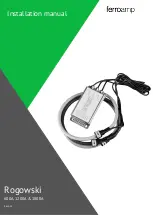MC1321x Serial Peripheral Interface (SPI)
MC1321x Reference Manual, Rev. 1.6
Freescale Semiconductor
4-15
4.8.5
SPI Data Register (SPI1D)
Reads of this register return the data read from the receive data buffer. Writes to this register write data to
the transmit data buffer. When the SPI is configured as a master, writing data to the transmit data buffer
initiates an SPI transfer.
Data should not be written to the transmit data buffer unless the SPI transmit buffer empty flag (SPTEF)
is set, indicating there is room in the transmit buffer to queue a new transmit byte.
Data may be read from SPI1D any time after SPRF is set and before another transfer is finished. Failure
to read the data out of the receive data buffer before a new transfer ends causes a receive overrun condition
and the data from the new transfer is lost.
4.9
Modem SPI Singular Transactions
Although the SPI port of the MCU transfers data in bursts of 8 bits, the MC1321x requires that a complete
SPI transaction be framed by CE, and there will be 3 or more bursts per transaction. There are generally
two classes of transactions, which are singular and recursive.
Both of the type transactions are used to access the modem SPI registers for reading and writing of data.
To view the modem SPI register map and descriptions of the modem registers, reference
“Modem SPI Register Descriptions”
.
4.9.1
SPI Singular Transaction Signalling
The assertion of CE to low signals the start of a transaction. The first SPI burst is a write of an 8-bit header
to the transceiver (MOSI is valid) that defines a 6-bit address of the internal resource being accessed and
identifies the access as being a read or write operation. In this context, a write is data written to the modem
and a read is data written to the SPI master. The following SPI bursts will be either the write data (MOSI
is valid) to the transceiver or read data from the transceiver (MISO is valid).
Although the SPI bus is capable of sending data simultaneously between master and slave, the MC1321x
never uses this mode. The number of data bytes (payload) will always be 2 for a singular access. After the
final SPI burst, CE is negated to high to signal the end of the transaction. Should a SPI programming
attempt fail to provide the modem with at least 24 rising SPICLK edges prior to CE negating, no register
data will be changed.
shows a read access transaction.
7
6
5
4
3
2
1
0
R
Bit 7
6
5
4
3
2
1
Bit 0
W
Reset
0
0
0
0
0
0
0
0
Figure 4-11. SPI Data Register (SPI1D)
Содержание freescale semiconductor MC13211
Страница 40: ...MC1321x Pins and Connections MC1321x Reference Manual Rev 1 6 2 6 Freescale Semiconductor...
Страница 100: ...MC1321x Serial Peripheral Interface SPI MC1321x Reference Manual Rev 1 6 4 24 Freescale Semiconductor...
Страница 166: ...Modem Modes of Operation MC1321x Reference Manual Rev 1 6 7 22 Freescale Semiconductor...
Страница 172: ...Modem Interrupt Description MC1321x Reference Manual Rev 1 6 8 6 Freescale Semiconductor...
Страница 186: ...MCU Modes of Operation MC1321x Reference Manual Rev 1 6 10 8 Freescale Semiconductor...
Страница 208: ...MCU Memory MC1321x Reference Manual Rev 1 6 11 22 Freescale Semiconductor...
Страница 244: ...MCU Parallel Input Output MC1321x Reference Manual Rev 1 6 13 20 Freescale Semiconductor...
Страница 288: ...MCU Central Processor Unit CPU MC1321x Reference Manual Rev 1 6 15 20 Freescale Semiconductor...
Страница 308: ...MCU Timer PWM TPM Module MC1321x Reference Manual Rev 1 6 17 16 Freescale Semiconductor...
Страница 338: ...Inter Integrated Circuit IIC MC1321x Reference Manual Rev 1 6 19 14 Freescale Semiconductor...
Страница 372: ...Development Support MC1321x Reference Manual Rev 1 6 21 20 Freescale Semiconductor...


















